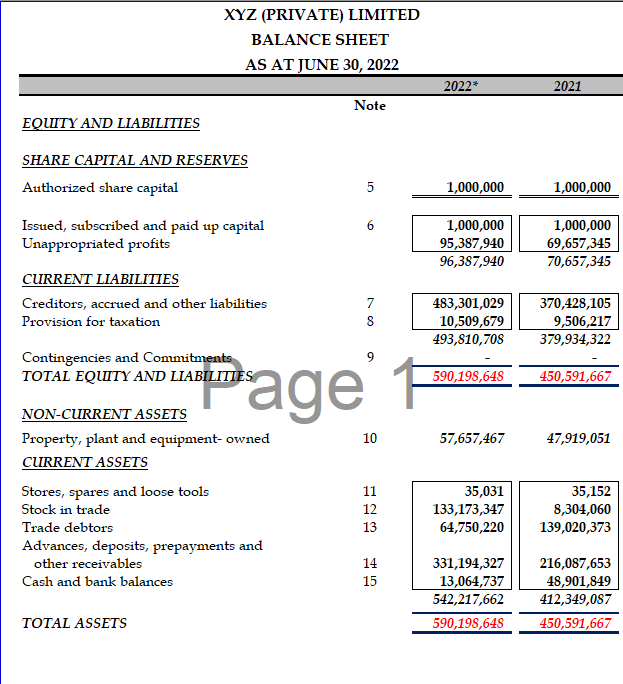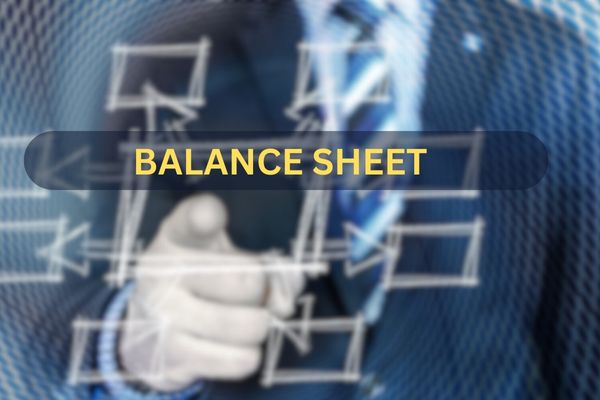A balance sheet is a financial statement that provides a snapshot of a company’s financial position at a specific point in time. It presents a summary of what a company owns (assets), what it owes (liabilities), and the shareholders’ stake in the company (equity). Understanding a balance sheet is crucial for assessing a company’s financial health, making investment decisions, and managing finances effectively.

Components of a Balance Sheet
A balance sheet consists of three main components: assets, liabilities, and equity. These components provide a detailed overview of a company’s financial position and aid in understanding its financial structure.
Assets
Assets represent what a company owns and controls. They can be categorized into current assets and fixed assets.
Current Assets
Current assets are short-term assets that are expected to be converted into cash within one year or the operating cycle of a business. Examples of current assets include:
- Cash and Cash Equivalents:
This includes cash on hand, checking accounts, and highly liquid investments.
- Accounts Receivable:
Amounts owed to the company by customers who have purchased goods or services on credit.
- Inventory:
Goods held by the company for sale or used in the production process.
Fixed Assets
Fixed assets, also known as non-current assets or property, plant, and equipment (PP&E), are long-term assets with a useful life of more than one year. They are not intended for sale but are essential for the company’s operations. Examples of fixed assets include:
1. Property, Plant, and Equipment:
This includes land, buildings, machinery, vehicles, and other tangible assets.
2. Intangible Assets:
Non-physical assets such as patents, trademarks, copyrights, and goodwill.
Liabilities
Liabilities represent what a company owes to external parties. Similar to assets, liabilities can be divided into current liabilities and long-term liabilities
Current Liabilities
Current liabilities are obligations that are expected to be settled within one year or the operating cycle of a business. They often require the use of current assets to fulfill these obligations. Examples of current liabilities include:
- Accounts Payable:
Amounts owed by the company to suppliers and vendors for goods or services received.
- Short-Term Loans:
Loans that are due within one year.
Long-term Liabilities
Long-term liabilities are obligations that extend beyond one year. They typically include loans, bonds, and other forms of long-term debt. Examples of long-term liabilities include:
1. Bonds Payable: Debt securities issued by the company to raise capital from investors.
2. Mortgages: Long-term loans used to finance the purchase of property or other fixed assets.
Equity
Equity represents the shareholders’ residual interest in the company after deducting liabilities from assets. It consists of two main components: common stock and retained earnings.
Common Stock
Common stock represents the initial capital invested by shareholders in exchange for ownership rights and voting privileges in the company.
Retained Earnings
Retained earnings reflect the accumulated profits or losses retained within the company since its inception. They result from the company reinvesting its profits or incurring net losses over time.
Understanding Assets
Assets are a critical component of a balance sheet and provide insights into a company’s ability to generate future cash flows. By analyzing the different types of assets, investors and financial professionals can gain a better understanding of a company’s operations and potential for growth.
Current Assets Explained
Current assets are highly liquid assets that can be readily converted into cash within a short period, usually within one year. They represent a company’s short-term resources that are necessary for day-to-day operations and fulfilling immediate financial obligations.
Cash and Cash Equivalents
Cash and cash equivalents are the most liquid current assets. They include physical currency, funds in checking and savings accounts, and short-term investments that can be quickly converted into cash. These assets provide the company with immediate access to funds, allowing it to meet short-term financial needs.
Accounts Receivable
Accounts receivable are amounts owed to the company by customers who have purchased goods or services on credit. They represent the company’s outstanding invoices that are expected to be collected in the near future. Managing accounts receivable effectively is crucial for maintaining a healthy cash flow and minimizing the risk of bad debts.
Inventory
Inventory consists of goods held by the company for sale or used in the production process. It includes raw materials, work-in-progress, and finished goods. Proper inventory management is essential to ensure efficient operations, prevent stockouts, and control costs.
Fixed Assets Explained
Fixed assets are long-term assets that are necessary for a company’s operations but are not intended for sale. They provide value to the company over an extended period and often require significant investments. Analyzing fixed assets helps assess a company’s growth potential and its ability to generate future cash flows.
Property, Plant, and Equipment
Property, plant, and equipment (PP&E) are tangible assets used in the production, manufacturing, or service delivery process. They include land, buildings, machinery, vehicles, and other physical assets. These assets are critical for a company’s operations and contribute to its ability to generate revenue.
Intangible Assets
Intangible assets are non-physical assets that lack physical substance but hold value for a company. They include intellectual property rights such as patents, trademarks, copyrights, and brand recognition. Intangible assets are often crucial for a company’s competitive advantage and long-term success.
Explaining Liabilities
Liabilities on a balance sheet represent the company’s obligations to external parties. They reflect the amounts owed by the company and the timeline for repayment Understanding liabilities helps assess a company’s financial obligations and its ability to meet them.
Current Liabilities Defined
Current liabilities are obligations that are expected to be settled within one year or the operating cycle of the business. They often arise from normal business operations and require the use of current assets to fulfill these obligations.
Accounts Payable
Accounts payable represent the amounts owed by the company to suppliers, vendors, or service providers for goods or services received. It reflects the company’s short-term debts and is a crucial component of managing working capital. Timely payment of accounts payable is essential to maintain good relationships with suppliers and ensure a smooth supply chain.
Short-Term Loans
Short-term loans are borrowings that are due for repayment within one year. They provide companies with temporary financing to meet immediate financial needs, such as funding operating expenses, inventory purchases, or capital investments. Monitoring and managing short-term loans help ensure the company’s liquidity and ability to honor its debt obligations.
Long-term Liabilities Explained
Long-term liabilities are obligations that extend beyond one year or the operating cycle of the business. They represent the company’s long-term financial commitments, usually in the form of loans or bonds.
Bonds Payable
Bonds payable are long-term debt securities issued by the company to raise capital from investors. They represent an agreement to repay the principal amount at a specified future date and pay periodic interest to bondholders. Bonds provide an alternative financing option for companies to fund large-scale projects or expansions.
Mortgages
Mortgages are long-term loans secured by specific assets, typically real estate properties. They enable companies to finance the purchase or development of property or other fixed assets. Mortgages involve regular repayments of principal and interest over an extended period, usually several years or decades.
Unpacking Equity
Equity represents the ownership interest in a company. It reflects the residual value after deducting liabilities from assets. Analyzing equity helps assess a company’s financial stability, ownership structure, and shareholders’ claims on the company’s assets.
Common Stock and Its Significance
Common stock represents the initial capital invested by shareholders in exchange for ownership rights and voting privileges in the company. It represents the ownership stake held by shareholders and provides them with certain rights, such as participating in decision-making processes and receiving dividends.
Retained Earnings and Their Importance
Retained earnings represent the accumulated profits or losses retained within the company since its inception. They reflect the portion of net income that has not been distributed to shareholders as dividends. Retained earnings are reinvested in the company to fund growth opportunities, repay debts, or strengthen the company’s financial position.
How to Read a Balance Sheet
Reading a balance sheet requires understanding its layout and the relationship between its components. By examining the balance sheet, stakeholders can assess a company’s financial health, liquidity, and solvency.
Understanding the Layout
A balance sheet is typically presented in a vertical format, with assets listed on the left side and liabilities and equity on the right side. The equation “Assets = Liabilities + Equity” signifies the fundamental accounting principle of double-entry bookkeeping.
Analyzing the Financial Health of a Company
When analyzing a balance sheet, several key financial ratios and indicators can provide insights into a company’s financial health:
- Current Ratio:
It measures a company’s ability to meet its short-term obligations. A higher current ratio indicates better short-term liquidity.
- Debt-to-Equity Ratio:
It assesses a company’s leverage and financial risk by comparing its total debt to its equity. A lower ratio suggests lower financial risk.
- Return on Equity (ROE):
It measures the profitability generated by the shareholders’ investment in the company. A higher ROE indicates efficient utilization of equity.
- Working Capital:
It represents the difference between current assets and current liabilities. Positive working capital indicates the company’s ability to cover short-term obligations.
Importance of Balance Sheets for Investors
Balance sheets play a crucial role in investment decision-making. Investors rely on balance sheet analysis to assess a company’s financial position, evaluate its stability, and make informed investment choices.
Assessing a Company’s Financial Position
By examining a company’s balance sheet, investors can gain insights into its asset quality, debt levels, and overall financial stability. This helps in understanding the company’s ability to generate cash flows, meet its obligations, and withstand economic downturns.
Making Informed Investment Decisions
Balance sheets provide valuable information to investors when evaluating investment opportunities. By comparing financial ratios, analyzing trends, and assessing the composition of a company’s assets and liabilities, investors can make informed decisions about investing in a particular company or industry.
Balance Sheets for Financial Management
Balance sheets serve as a valuable tool for financial management within a company. They provide essential information for tracking financial performance, facilitating financial planning, and making strategic decisions.
Tracking Financial Performance
By regularly reviewing balance sheets, companies can monitor their financial performance and identify areas for improvement. It helps in analyzing the company’s revenue generation, asset utilization, and debt management.
Facilitating Financial Planning
Balance sheets provide the necessary data for financial planning and forecasting. By understanding the company’s financial position, management can make informed decisions regarding budgeting, capital allocation, and investment strategies.
Limitations of Balance Sheets
While balance sheets are essential financial statements, they have certain limitations that should be considered.
Historical Nature of the Information
Balance sheets provide a snapshot of a company’s financial position at a specific point in time. They reflect historical data and may not capture the dynamic nature of a company’s financial condition or changes that occurred after the balance sheet date.
Not Capturing Qualitative Aspects
Balance sheets primarily focus on quantitative aspects of a company’s financial position. They do not capture qualitative factors such as management quality, industry trends, or competitive advantages. Therefore, it is important to complement balance sheet analysis with other forms of research and analysis.
Conclusion
In conclusion, a balance sheet is a vital financial statement that provides insights into a company’s financial position, including its assets, liabilities, and equity. It helps stakeholders evaluate a company’s financial health, make investment decisions, and manage finances effectively. Understanding the components of a balance sheet and analyzing its ratios and indicators can provide valuable information for investors, financial professionals, and companies themselves. By leveraging the information provided by balance sheets, stakeholders can make informed decisions and navigate the financial landscape with confidence.




